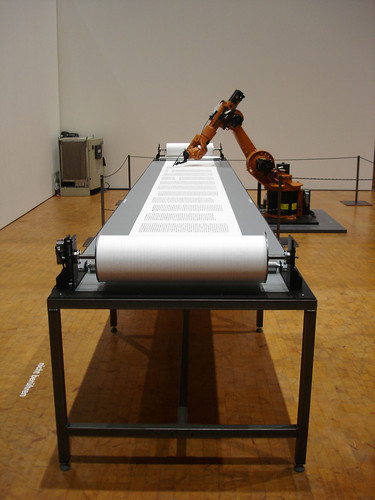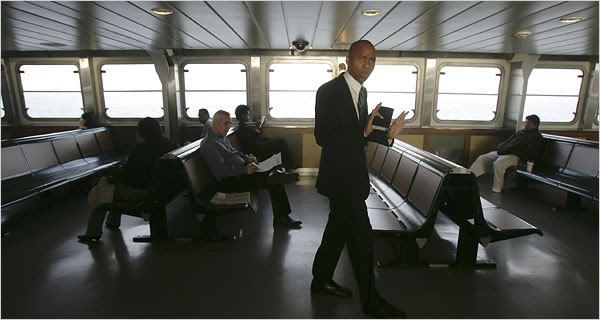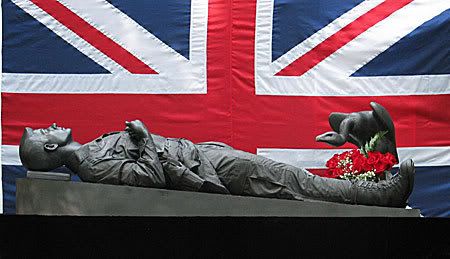For something which should have been handled very delicately and discretely, the SGPC has made a mess of the entire affair. ...
Wednesday, October 31, 2007
Sikh battles over publishing and transporting Guru Granth
Tuesday, October 30, 2007
Bibles as Foundation Deposits
... Building homes with a Bible in the foundation is not something they advertise, but it's not something they hide, either.Textual foundation deposits were common in antiquity, but I have not run across other examples of using scriptures in this way more recently. Does anyone know of other examples?
"The Bible symbolizes the godly principles we use in our company," Wallace said. "We felt that if we built our company on a godly foundation, God would bless our company."
"We do it more for us than anything else," Eckert said.
Besides the Bible, brief Scripture passages, appropriate for the individual room, get printed on the wood framework of those rooms. A passage about children, for example, is printed with permanent marker on the wall studs of a room intended for kids. On the door frame of another house is the opening verse of Psalm 127, which refers to God establishing houses, or families.
"It's nice for me to have a reminder in there when I'm walking through the frame of where my principles are," Eckert said. "It keeps me straight."
... At least one other company, however, has been doing something similar with the Bible for at least a dozen years in the Dallas-Fort Worth area.
... On the day the foundation is poured at Possibility Homes , a soft-covered Bible is placed at the outside corner of the master bedroom - "where the spiritual leaders of the house stay," according to Eckert - or somewhere else if the buyer prefers.
The book is open to the center, the concrete is poured from a huge boom connected to a truck. Workers then smooth the area along with the rest of the foundation.
Monday, October 29, 2007
Robot Scribe
 A German group, Robotlab, has constructed this robotic arm that does calligraphy. (Thanks to Michael Lieberman for this tip.) In this display, it is "hand" writing the Luther Bible. Note the use of THE iconic German Bible for purposes of this demonstration.
A German group, Robotlab, has constructed this robotic arm that does calligraphy. (Thanks to Michael Lieberman for this tip.) In this display, it is "hand" writing the Luther Bible. Note the use of THE iconic German Bible for purposes of this demonstration.One commenter notes the irony in choosing this text to render mechanically in imitation calligraphy when it was originally printed. Another irony is the choice of the scroll form for the convenience of the machine, instead of the codex sheets more easily handled by printing presses.
 Advocates of the possibilities inherent in new electronic media (such as the folks at if:book) often decry the wide-spread tendency to use new technology anachronistically, rather than taking advantages of its possibilities. They would probably not be comforted by the observation that this tendency is very old. This robot reproduces calligraphy because, despite five-and-a-half centuries of printing, careful hand calligraphy retains connotations of prestige and expense. Thus famous documents, like the U.S. Declaration of Independence and Constitution, are displayed and reproduced in calligraphic form, which is how they are popularly remembered, despite the fact that the originals were printed broadsheets. It was the secondary, anachronistic hand-written form that was given iconic status.
Advocates of the possibilities inherent in new electronic media (such as the folks at if:book) often decry the wide-spread tendency to use new technology anachronistically, rather than taking advantages of its possibilities. They would probably not be comforted by the observation that this tendency is very old. This robot reproduces calligraphy because, despite five-and-a-half centuries of printing, careful hand calligraphy retains connotations of prestige and expense. Thus famous documents, like the U.S. Declaration of Independence and Constitution, are displayed and reproduced in calligraphic form, which is how they are popularly remembered, despite the fact that the originals were printed broadsheets. It was the secondary, anachronistic hand-written form that was given iconic status.
Sunday, October 28, 2007
"The Man With the Bible" in the NYT

A recent New York Times article demonstrates one of the most common iconic uses of a Bible in visual or descriptive media: the Bible serves as the distinguishing feature marking its holder as a Christian or a preacher. The headline, accompanying photograph, and second paragraph of "Rocking the Boat: The Man With the Bible" all foreground the Bible as the trait that setting Michael Nwadiuko apart from the other passengers on the Spirit of America ferry:
Rocking the Boat: The Man With the BibleThe use of the Bible as the marker of identity is curious in this introduction, as the rest of the article examines another way in which Mr. Nwadiuko reveals his "more spiritual aspirations" as it discusses his (often unwelcome) preaching to the other passengers. The article is not about a man "with" a Bible or "only the Bible in one hand" as much as it is about a man talking to other passengers, yet the author and photographer have made choices to signal Mr. Nwadiuko's identity primarily with his Bible.
AS the Spirit of America’s engines sputtered to life early last Tuesday and the ferry began its trip from Staten Island to Lower Manhattan, Michael Nwadiuko strode purposefully toward the back of the main deck, where groggy commuters read the morning paper and nursed cups of coffee.
In his navy suit and gray tie, Mr. Nwadiuko looked as if he were headed to a job on Wall Street. Only the Bible in one hand revealed his more spiritual aspirations.
[. . .]
Saturday, October 27, 2007
Oklahoma politicians return gift of Qur'an
Two dozen Oklahoma lawmakers plan to return copies of the Quran to a state panel on diversity after a lawmaker claimed the Muslim holy book condones the killing of innocent people.
The books were given to Oklahoma's 149 senators and representatives by the Governor's Ethnic American Advisory Council.
The lawmakers' intention to return the Qur'ans led to their denunciation by the Jewish Federation of Tulsa and several local interfaith groups, as well as the Council on American-Islamic Relations.
Like other public arguments involving American politicians and Qur'ans in recent years, this debate shows how much attention public officials pay (even if clumsily, as in this case) to the iconic functions of scriptures--far more than do most scholars of those scriptures and religions.
November 10, 2007: The Tulsa World now reports that both the lawmakers and the Ethnic American Advisory Council have been surprised by the worldwide press attention to this story. So the politicians underestimated the iconic function of scriptures, too. This is yet another example of why serious analysis of the phenomenon of iconic texts is needed.
Wednesday, October 24, 2007
Problems at Library of Congress

This picture is of the stacks of the U.S. Library of Congress in Washington, suffering from staff shortages and budget cuts according to a new Inspector General's survey that has prompted outraged headlines in the Washington Post and on Book Patrol.
This blog notes lavish attention to particular books and in particular places, but we should give some notice to the lack of care for books in institutions from which we have every reason to expect better.
Update, November 2, 2007: Matt Raymond has responded on behalf of the Library of Congress on its own blog. For more reactions, see Book Patrol and PhiloBiblos.
Tuesday, October 23, 2007
A Million Pound Qur'an

In addition to enormous artistic and religious value, some books also have enormous economic value, such as the 13th century Qur'an which sold for millions of your preferred currency at an auction at Christie's:
LONDON (AFP) - A 13th century Koran was sold on Tuesday for a world record price of 1,140,500 pounds (2,320,917 dollars, 1,632,055 euros), auction house Christie's said.[. . .]
Dated to 1203 and written entirely in gold, with marginal notes in silver, it is the earliest known complete, dated Koran, written in gold in the world, and broke the record for a Koran, and the record for any Islamic manuscript, sold at auction.
[. . .]
Sunday, October 21, 2007
Hitler's Honors
 Salt Lake City police have recovered stolen memorabilia that once belonged to Adolf Hitler, including several elaborate documents lavishing honors on him (see the photo gallery). From an Iconic Books perspective, the wooden box in which they were stored (best seen in the news clip from Spiegel TV) is as revealing as the documents themselves for emphasizing the value that was placed on these paper items. (Thanks to my colleague, Albrecht Diem, for bringing this news to my attention.)
Salt Lake City police have recovered stolen memorabilia that once belonged to Adolf Hitler, including several elaborate documents lavishing honors on him (see the photo gallery). From an Iconic Books perspective, the wooden box in which they were stored (best seen in the news clip from Spiegel TV) is as revealing as the documents themselves for emphasizing the value that was placed on these paper items. (Thanks to my colleague, Albrecht Diem, for bringing this news to my attention.)Friday, October 19, 2007
Making do with the Fetish
Thursday, October 18, 2007
Images to be Read and Words to be Seen
Available here is the program for the whole Symposium as well as a news release about it.
Monday, October 15, 2007
Chinese text & book art
 Book Art has come a long way: The July/August edition of the Atlantic dubbed Xu Bing’s “The Book From the Sky” (1987-1991) “one of the most important works of 20th-century Chinese Art." For a better image of his installation, see the online slide show, “Visionaries from the New China,” which ends with another of Bing’s word/book pieces, “The Living Word” (2001). (Thanks to my colleague, Sam Gorovitz, for pointing out this article.)
Book Art has come a long way: The July/August edition of the Atlantic dubbed Xu Bing’s “The Book From the Sky” (1987-1991) “one of the most important works of 20th-century Chinese Art." For a better image of his installation, see the online slide show, “Visionaries from the New China,” which ends with another of Bing’s word/book pieces, “The Living Word” (2001). (Thanks to my colleague, Sam Gorovitz, for pointing out this article.)(October 23) Michael Lieberman on Book Patrol calls attention to an exhibit of many pieces by Chinese artists featuring books at the Seattle Asian Art Museum. The catalog of the exhibit, Shu: Reinventing Books in Contemporary Chinese Art, claims that "in Chinese Contemporary Art there are few objects as important as the book."
(2014: See Zak Braiterman's reaction to the Met's display of Bing's installation.)
Friday, October 12, 2007
Prince Harry Sculpture

I am curious about the ritual this artist is portraying, and I would appreciate comments on it. Plutarch mentions that Alexander the Great kept a copy of the Iliad beneath his bed when he was on campaign, so there is a long precedent for keeping one's favorite text nearby, but I'd like to know if this is done in funeral or burial rituals. Does any funeral practice (past or present, any culture) really include using scripture in this manner or is this an artistic trope?
Wednesday, October 10, 2007
The Joy of Leather Bibles

For sheer celebration of the materiality of leather-bound Bibles, I've found little that can compare with the Bible Design & Binding blog by J. Mark Bertrand, who revels in limp goatskin bindings, crisp red lettering, and wide margins. He publicizes future releases of new bindings and evaluates the relative benefits of binding construction. Others' comments on his posts echo his enthusiasm and show that he is hardly unique.
A Toddler's Torah Set
Another way to develop one's sense of scripture-as-icon is through play, which in this case is facilitated by KidKraft's Torah Set.

The sales pitch promises all kinds of educational religious fun:
Fun and nurturing Jewish values come together in KidKraft's brightly colored Torah set. Perfect for children 3 and up and great for pretend play, kids can spend hours playing with their very own Torah set, including:
* A colorful wooden Ahron Kodesh to keep the Torahs safe
* 2 navy blue plush curtains that open and close, finished with the Star of David
* 2 plush, roll-up Torahs finished in corresponding colors of red and blue
Monday, October 8, 2007
Artistic Giant Quran

The Tehran Times reports that a giant "work of art, in the form of an open Quran, was made by 30 artists from Isfahan." The open pages measure 3 x 4 meters. The piece was created for display at this month's 15th International Holy Quran exhibit in Tehran.
Saturday, October 6, 2007
Trouble over publishing Guru Granth in Punjab
In a bizarre incident, agitated activists of the Guru Granth Sahib Satkar Committee picked up two brothers from the shop of famous publishers Jeewan Singh Chattar Singh and Sons, near Golden Temple, and blackened their faces in full public view.
The brothers are accused of selling 50 “birs” of Guru Granth Sahib to a Delhi-based Sikh couple. The activists of the committee followed the vehicle of the couple Surinder Singh and his wife up to Beas. They intercepted them and compelled them to return to Amritsar. The agitating Sikh activists alleged that the birs were stacked in the Delhi couple’s vehicle and they were wearing shoes. It is alleged that the couple wanted to sell the birs at a high price. It is alleged that both brothers were first beaten up in full public view and then in the room of Akal Takht. The heavy police force that reached the incident site could not intervene because of the surcharged religious sentiments.
Tuesday, October 2, 2007
Introducing Le book
Technological change is soooooo hard!





